Draft beer has become increasingly popular among craft beer enthusiasts, known for its unparalleled freshness and vibrant flavours. Unlike bottled or canned beer, which can be exposed to light and oxygen, draft beer is stored in kegs or casks and dispensed directly from taps.
Draft beer, often seen as the pinnacle of freshness and flavour, offers a unique experience that elevates ordinary moments into something memorable.
This guide aims to demystify draft beer, exploring its meaning, production, unique qualities, different types, Key Differences Between Draft and Bottled Beer, and serving techniques.
A Brief History of Draft Beer
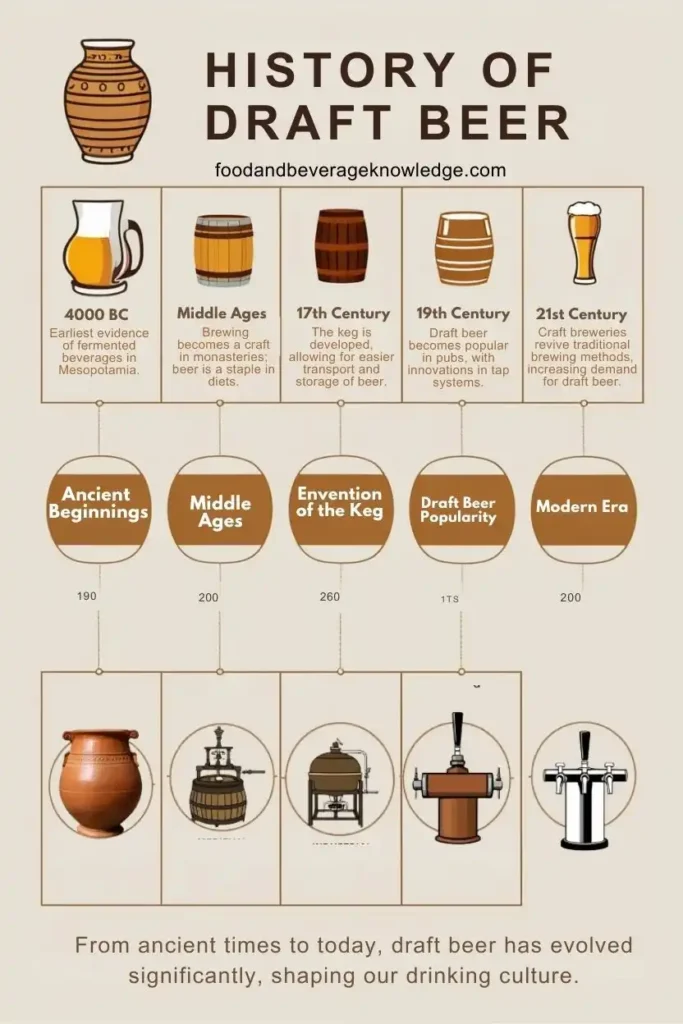
Draft beer has a rich history that dates back to ancient times. Early Sumerians brewed beer around 5,000 BCE, storing it in clay jars that could be tapped for easy serving.
In medieval Europe, particularly within monasteries, the development of cask ale emerged, where beer was naturally carbonated and served from wooden barrels.
The Industrial Revolution in the 18th and 19th centuries introduced metal kegs, which improved beer storage and transportation, leading to the rise of public houses where patrons enjoyed draft beer directly from taps.
The late 20th century saw a revival of interest in traditional brewing methods with the craft beer movement, emphasizing quality and unique flavours.
Today, draft beer remains a beloved choice for its freshness and vibrant taste, celebrated in bars and restaurants worldwide.
For a deeper dive into the history of beer, you can explore resources like Wikipedia and BeerAdvocate
What is Draft Beer? Understanding the Basics
Draft beer, also known as draught beer, is beer served from a keg or cask rather than a bottle or can. Unlike packaged beer, draft beer is typically fresher and has a fuller flavor due to minimal exposure to light and oxygen.
This type of beer is stored in kegs and served through pressurized taps, which helps maintain its carbonation and taste.
Draft beer comes in various types, including keg beer, which is carbonated with CO₂, and cask ale, which is naturally carbonated and unfiltered, offering a smoother mouthfeel.
Many people prefer draft beer for its fresh taste and unique pouring experience.
Draft vs. Draught Beer: What’s the Difference?
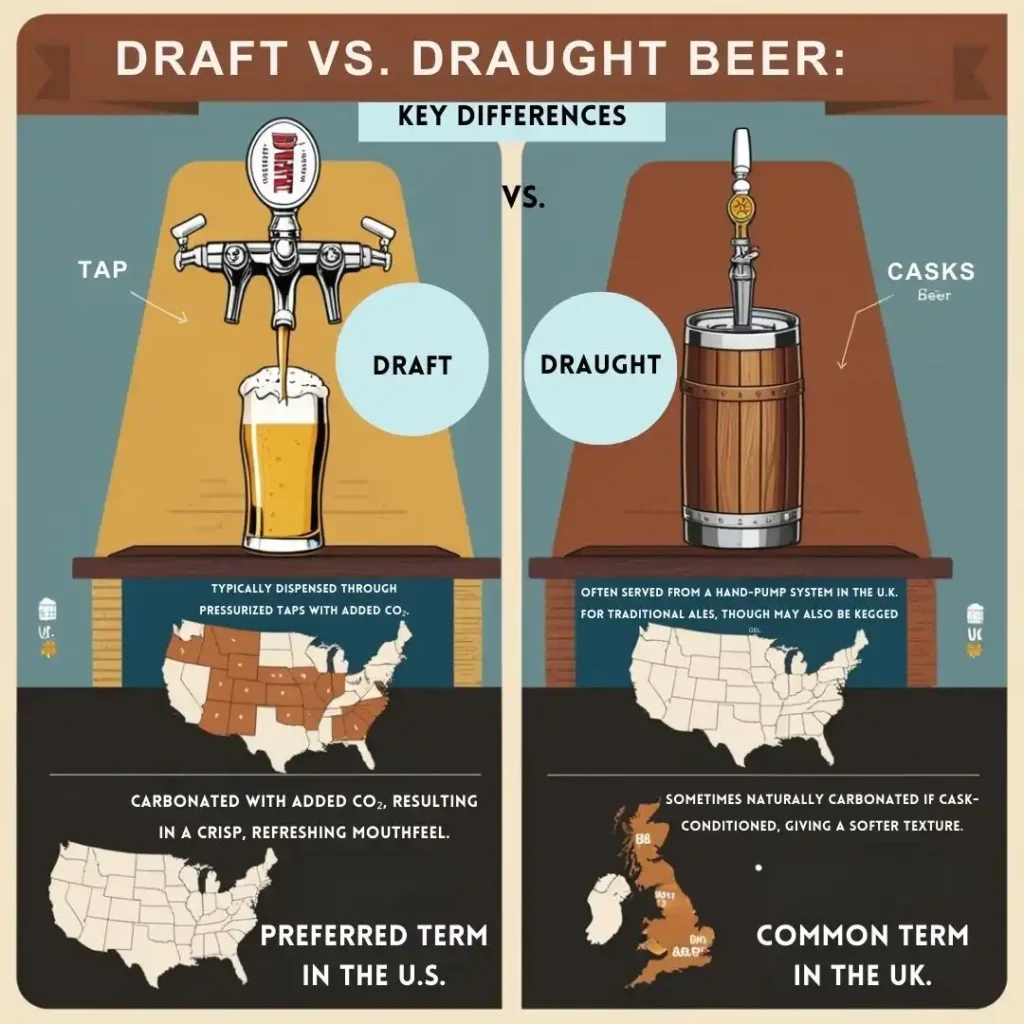
When ordering beer, you might see it labelled as either “draft” or “draught.” While these terms are often used interchangeably, they have subtle differences that vary by region and serving style. Let’s break down the main distinctions.
1. Terminology and Regional Preference
- Draft Beer: The term “draft” is primarily used in the United States to refer to beer served from a keg, tap, or cask. It’s a general term encompassing any beer served fresh from a pressurized system, typically found in bars and pubs.
- Draught Beer: Used more commonly in the United Kingdom and Commonwealth countries, “draught” historically referred to cask-conditioned ales served using a hand-pump system. Today, it also includes kegged beer but is associated with a more traditional beer-serving style.
2. Serving Method
- Draft Beer: Served through pressurized taps, usually with added CO₂, which keeps the beer fresh and provides a crisp, carbonated mouthfeel.
- Draught Beer: Frequently served through a hand pump or gravity system, especially for traditional ales in the U.K. This method results in softer carbonation and a smoother, more authentic flavour, especially for cask ales.
3. Carbonation and Flavor
- Draft Beer: Known for its crisp and refreshing quality, draft beer typically has added CO₂, offering a stable and consistent flavour profile.
- Draught Beer: If cask-conditioned, draught beer has natural carbonation from secondary fermentation, giving it a gentle effervescence and allowing for more complex flavours to develop.
Final Thoughts
While both draft and draught beer are served fresh from a keg or cask, draft generally refers to American-style, pressurized beer, while draught emphasizes a traditional, authentic serving method popular in the U.K. and Commonwealth countries.
Whether you prefer the crispness of the draft or the nuanced flavours of draught, knowing these distinctions can enhance your appreciation of each pour.
Key Differences Between Draft and Bottled Beer
When it comes to enjoying beer, the choice between draft and bottled beer can significantly affect the flavour, freshness, and overall experience. Here are the key differences:
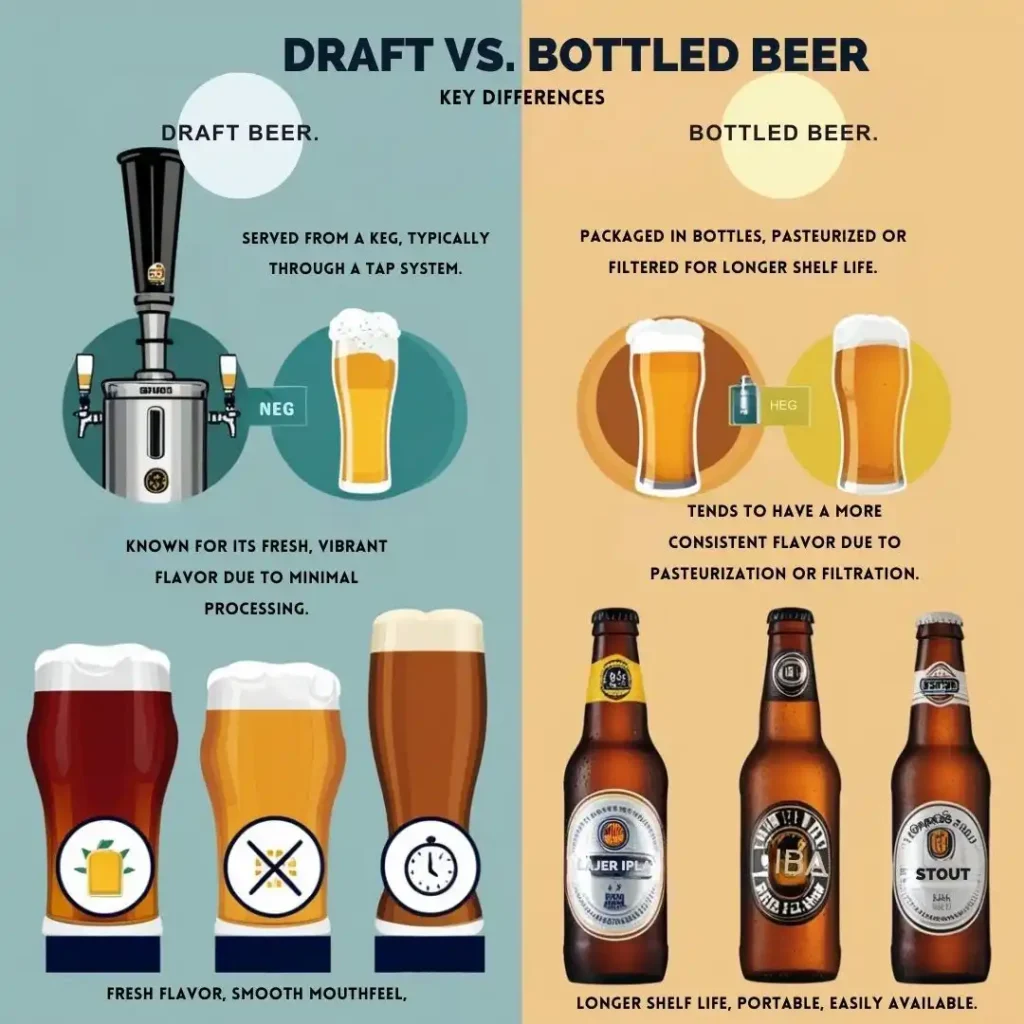
Storage and Dispensing:
- Draft Beer: Stored in kegs and dispensed through taps, draft beer typically maintains freshness and carbonation levels better than bottled beer. The pressurized environment of a keg helps preserve the beer’s intended flavour profile until served.
- Bottled Beer: Packaged in bottles, which can be susceptible to light and oxygen exposure, bottled beer often has a shorter shelf life. The cap can introduce oxygen when opened, potentially affecting the taste over time.
Freshness:
- Draft Beer: Generally considered fresher, draft beer is often served directly from the keg to the glass, minimizing exposure to air and light, which can degrade flavour. Many craft breweries even serve their beers on draft within days of brewing.
- Bottled Beer: While many bottled beers are also crafted with care, the time between brewing, bottling, and consumption can lead to less freshness compared to draft beer. Some styles of beer, like IPAs, are best consumed fresh, making draft a more appealing option.
Flavor Profile:
- Draft Beer: The serving process can enhance the beer’s aroma and flavor. The larger serving size and proper pouring techniques in bars can contribute to a better-tasting experience.
- Bottled Beer: Flavor can vary due to bottle conditioning or pasteurization, which may alter the beer’s original taste. However, many bottled beers, especially craft options, are brewed with an emphasis on unique flavours and ingredients.
Carbonation Levels:
- Draft Beer: Typically has a smoother and creamier mouthfeel due to the nitrogen or CO2 dispensing methods used in bars. The controlled environment allows for consistent carbonation levels.
- Bottled Beer: Carbonation can vary depending on the bottling process and whether the beer is bottle-conditioned. This can lead to a different mouthfeel and experience when drinking.
Availability and Variety:
- Draft Beer: Often showcases local breweries and limited-edition releases that may not be available in bottles. Bars frequently rotate their draft selections to offer customers new experiences.
- Bottled Beer: Widely available and can be purchased for home consumption, offering a broader selection of styles and brands, including those that may not be on draft.
Also Read: What are the different types of beer?
How Draft Beer is Made and Stored
Production Process of Draft Beer
The production of draft beer follows the same basic brewing principles as bottled beer but is tailored for optimal freshness. The brewing process involves:
- Mashing: Combining malted grains with water to extract sugars.
- Boiling: Adding hops to impart bitterness and aroma.
- Fermentation: Yeast converts sugars into alcohol and carbon dioxide.
- Conditioning: Beer is allowed to mature, which develops its flavour.
This production method emphasizes quality, and many breweries produce draft beer specifically for tap systems, ensuring it retains its freshness from brewery to glass. If you want to learn the beer-making process check out our guide on: How Beer is Made: A Detailed Step-by-Step Guide
Keg and Cask Storage
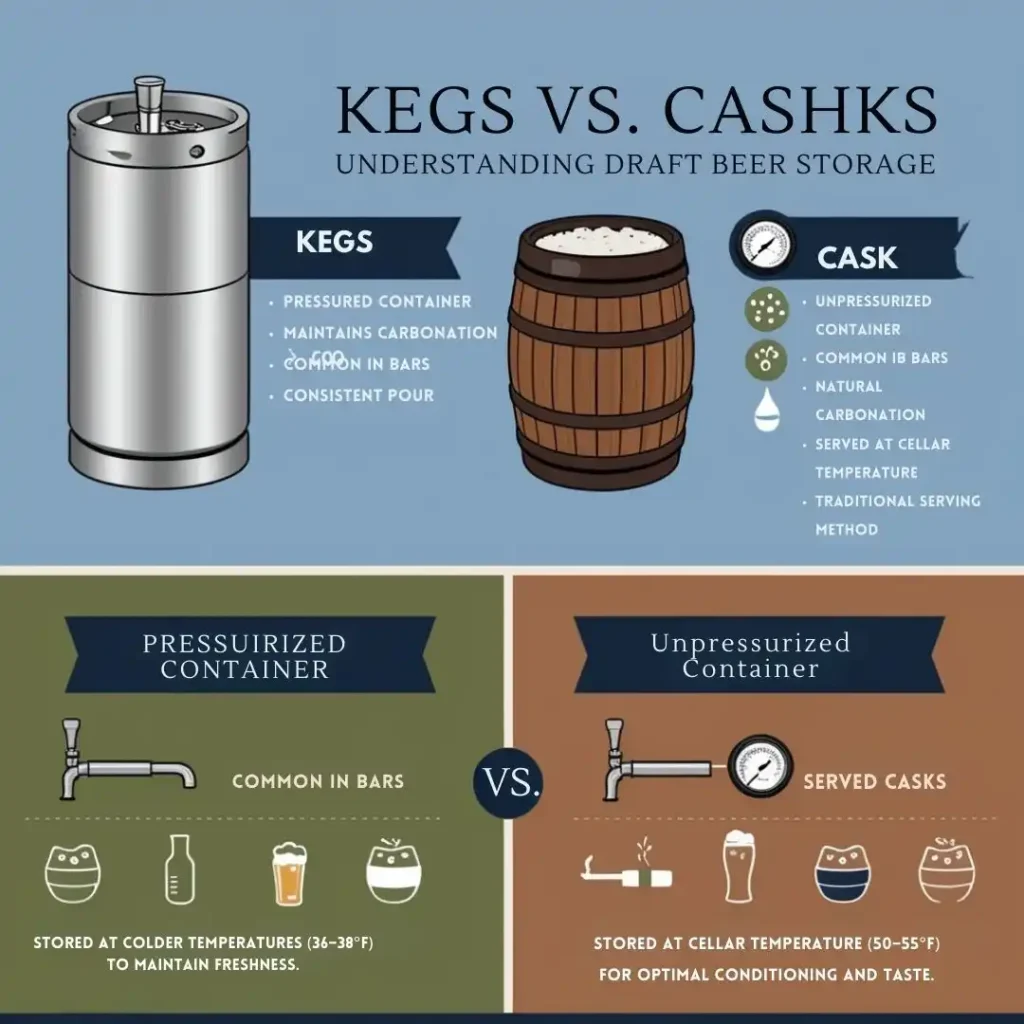
Key Differences Between Keg and Cask Storage
Let’s break down the main differences to see how each storage method affects the beer experience:
Carbonation
- Keg: Uses external CO₂ to maintain a consistent level of carbonation, resulting in a crisp, refreshing mouthfeel.
- Cask: Carbonation is naturally produced through fermentation in the cask, giving the beer a softer, more subtle effervescence.
Temperature Requirements
- Keg: Stored at colder temperatures (36–38°F) to retain freshness and consistency. This setup is typical for beers that benefit from a crisp, cold serve.
- Cask: Stored at cellar temperatures (50–55°F) to enhance natural conditioning. These warmer temperatures allow the beer’s flavours to develop and mellow, making them more pronounced upon serving.
Serving Temperature
- Keg: Typically served at 38–42°F, giving it a refreshing, chilled quality that’s popular in warmer environments and with highly carbonated beer styles.
- Cask: Served around 50–55°F, providing a more balanced, nuanced flavour experience, especially suited for traditional ale styles.
Handling and Dispensing
- Keg: Requires a pressurized tap system with CO₂ for dispensing, which maintains carbonation throughout the serving process.
- Cask: Dispensed by gravity or through a hand-pump system (beer engine), preserving the natural carbonation without adding external gases.
Shelf Life
- Keg: Due to refrigeration and pressurization, kegs have a longer shelf life, sometimes lasting weeks or even months if unopened.
- Cask: With a shorter shelf life (around 3–7 days once tapped), cask beer is best consumed fresh to capture its authentic flavour profile.
Flavor Profile
- Keg: Offers consistent, stable flavours that are preserved over time. CO₂ pressurization keeps the taste reliable and well-carbonated.
- Cask: Known for its dynamic flavour profile that evolves with time. Natural conditioning gives it a unique, evolving character that adds depth and complexity to each pint.
For more on Keg beer read on Wikipedia draft beer
Draft Beer Storage and Temperature Control
Maintaining proper storage conditions is crucial for draft beer. The ideal temperature range for draft beer storage is between 38°F and 50°F (3°C to 10°C). Beer that is too warm can spoil quickly, while excessively cold temperatures can dull flavours.
Additionally, draft systems should be regularly maintained to prevent contamination and ensure optimal flavour.
Also Read: Beer Glasses: The Ultimate Guide to Choosing the Right Glassware
The Unique Qualities of Draft Beer
Freshness and Flavor Profile
Draft beer is celebrated for its freshness, which significantly impacts its flavour profile. The reduced exposure to light and oxygen helps retain the beer’s intended taste, allowing the unique characteristics of the ingredients to shine through.
For instance, hoppy IPAs can showcase their aromatic profiles, while malty stouts can deliver rich, chocolatey notes.
Draft Beer Alcohol Content
The alcohol content of draft beer varies based on the style, typically ranging from 4% to 8% ABV (alcohol by volume). However, some craft beers can exceed this range, reaching up to 12% or more.
Understanding alcohol content is important for responsible consumption and can enhance the overall drinking experience.
The flavor of draft beer can be distinctively richer than that of bottled beer, due to its unpasteurized and minimally processed nature.
The American Society of Brewing Chemists notes that draft beer’s natural carbonation helps accentuate flavours, making it especially appealing for beer connoisseurs.
Dispensing Draft Beer: The Equipment & Techniques
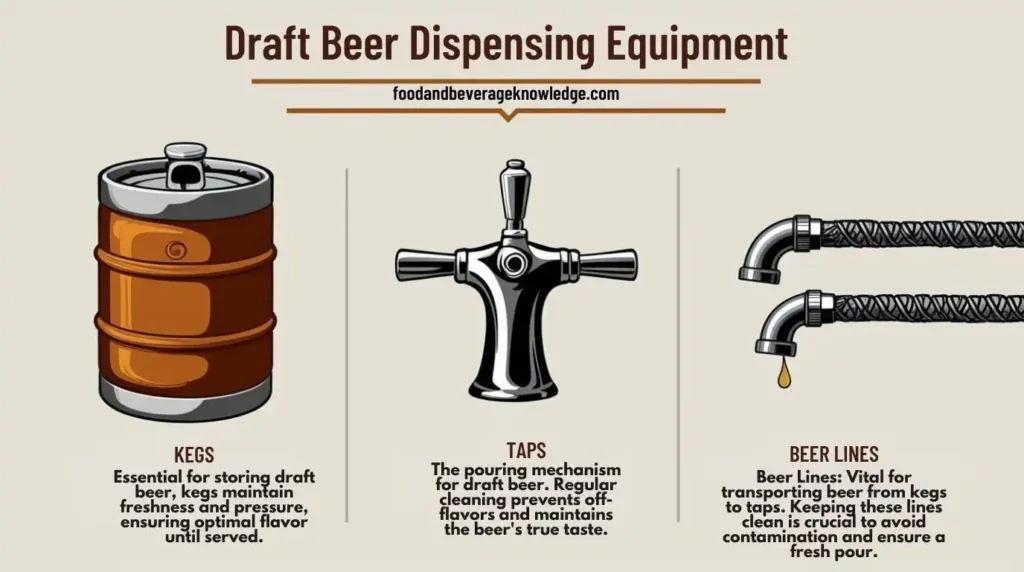
Kegs, Taps, and Beer Lines
The quality of draft beer is heavily influenced by its dispensing equipment. Key components include:
- Kegs: These store the beer and maintain its freshness.
- Taps: The system used to pour beer from kegs; they should be cleaned regularly to prevent off-flavours.
- Beer Lines: The hoses that connect kegs to taps must also be kept clean to avoid contamination.
Regular maintenance of this equipment is essential for ensuring that every pour is as fresh as possible.
Types of Draft Beer Dispensers
Draft beer is dispensed using either CO2 or a nitrogen mix.
- CO2 Systems: Provide a crisp, carbonated experience and are most common for beers that benefit from higher carbonation levels.
- Nitrogen Systems: Create a smoother, creamier mouthfeel, which is ideal for stouts and porters . Understanding the differences in dispensing can help consumers choose the right beer for their preferences.
Tap Cleaning and Maintenance
To maintain the quality of draft beer, regular cleaning of the tap system is vital. Tap lines should be cleaned every two weeks to prevent the build-up of bacteria and residue, which can lead to off-flavours.
Ensuring a clean tap system not only enhances flavor but also promotes better customer experiences.
Types of Draft Beer: Keg, Cask, and More
Draft beer is widely appreciated for its fresh, vibrant flavours, but did you know there are various types of draft beer, each served from different systems and offering unique characteristics?
From traditional cask ales to the pressurised kegs commonly used in bars, each draft beer type offers a unique experience.
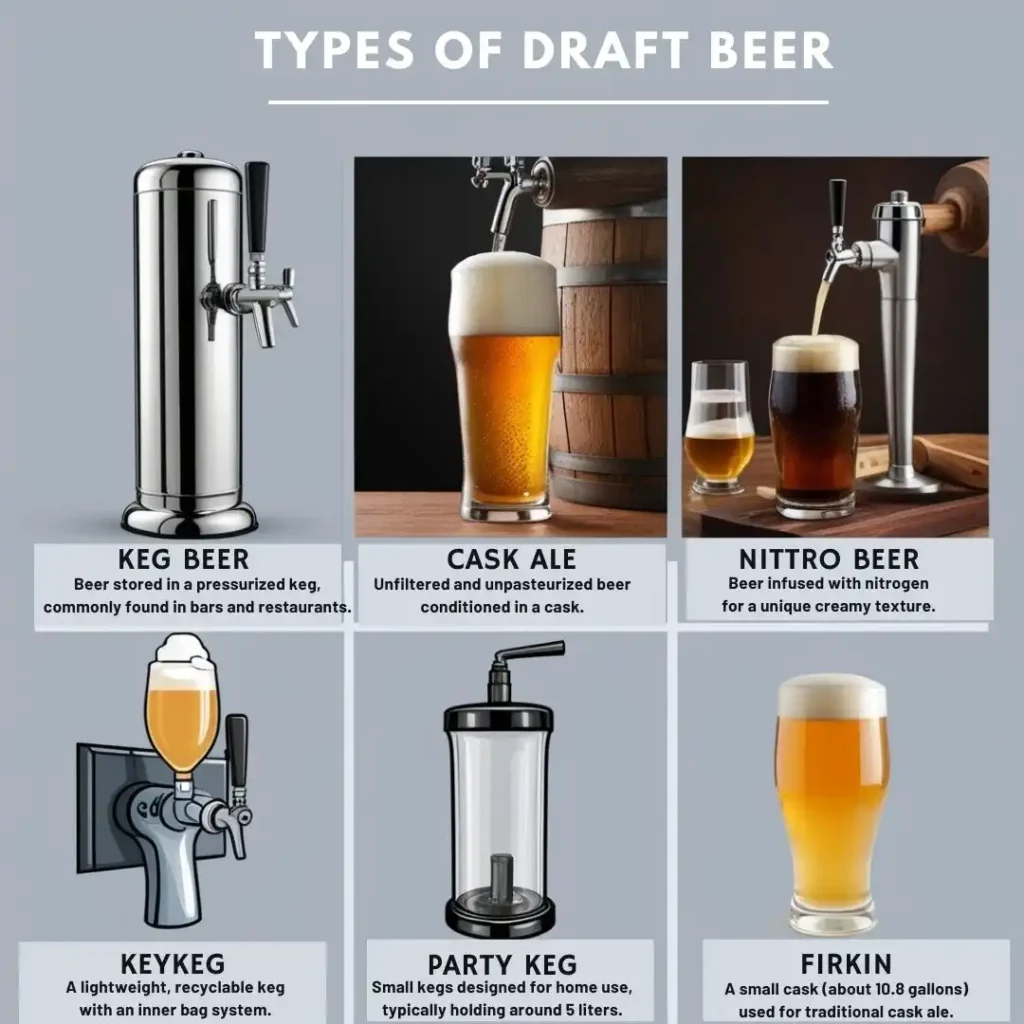
Here’s a closer look at the main types of draft beer and what makes each one distinct.
1. Keg Beer
Keg beer is one of the most popular types of draft beer, widely served in bars, restaurants, and pubs. Stored in a pressurised container, it’s typically kept at a controlled temperature and served using CO₂ or mixed gas, maintaining freshness and carbonation.
This system allows for a consistent, crisp pour every time, making it ideal for a wide range of beer styles.
- Common Styles: Lagers, IPAs, stouts, and more
- Flavor Profile: Clean, with balanced carbonation and consistent freshness
- Serving Method: Dispensed through a tap system using CO₂ or nitrogen for a controlled pour
2. Cask Ale
Cask ale, also known as “real ale,” is a traditional British beer style that’s naturally carbonated and conditioned in the cask itself, without additional CO₂. Served through a hand pump or by gravity (without added gas), cask ale is unpasteurized and often served at cellar temperature, offering a smoother mouthfeel and complex flavours.
- Common Styles: English ales, bitters, porters
- Flavour Profile: Naturally carbonated, with a softer texture and nuanced flavors that develop over time
- Serving Method: Poured through a hand pump or by gravity, without added gas, offering a more traditional, authentic experience
3. Nitro Beer
Nitro beers are pressurised with nitrogen instead of CO₂, giving the beer a creamy, smooth mouthfeel and a cascading effect in the glass. Nitrogen’s smaller bubbles make for a softer carbonation, ideal for richer beer styles that benefit from a velvety texture.
Nitro taps are commonly used for stouts and porters but have expanded to other styles for a unique draft experience.
- Common Styles: Stouts (e.g., Guinness), porters, cream ales
- Flavor Profile: Smooth, creamy, with a thick head and a rich texture
- Serving Method: Dispensed with a nitrogen tap system for a cascading pour and creamy finish
4. KeyKeg
The KeyKeg is a newer draft beer system that utilises a lightweight, recyclable keg with an inner bag. Beer is stored in this bag, and when gas pressure is applied, the bag pushes the beer out without direct contact with the gas, preserving its natural flavour profile.
KeyKegs are popular for their convenience and sustainability, as they’re easy to transport and fully recyclable.
- Common Styles: Wide variety, especially popular with craft breweries
- Flavor Profile: Retains freshness, with no CO₂ contact, preserving the beer’s original taste
- Serving Method: Uses an inner bag system where gas pressure pushes the beer out, reducing oxygen exposure
5. Party Keg (Mini Keg)
Party kegs, or mini kegs, are small, portable kegs designed for home or small gatherings. Typically holding around 5 litres (just over a gallon), they’re easy to transport and set up, allowing you to enjoy draft beer without needing complex tap systems.
Party kegs are perfect for gatherings and give beer enthusiasts a draft experience outside of a pub setting.
- Common Styles: Lagers, pilsners, and session ales that benefit from fresh pouring
- Flavour Profile: Fresh taste, usually similar to the canned or bottled versions of the beer
- Serving Method: Often includes a built-in tap for easy pouring, with CO₂ cartridges for added carbonation in some cases
6. Growlers and Crowlers
Though not a draft system itself, growlers and crowlers offer a way to take draft beer to-go. Growlers are refillable glass or stainless steel containers, while crowlers are single-use cans filled and sealed on-site at breweries or bars.
Both allow for the freshness of draft beer at home, though growlers typically need to be consumed it within a day or two to retain quality.
Serving Method: Filled on-site, typically with a limited shelf life once opened
Common Styles: Any draft beer style, depending on the brewery’s selection
Flavour Profile: Maintains the draft taste for a limited time, ideally consumed fresh
Learn more about types of craft beer from the Craft Beer Association or explore popular varieties like nitro beers, famously represented by breweries like Guinness.
Also Read: Top 13 Most Popular Beer Brands in the World
Why Draft Beer Tastes Different

Freshness and Reduced Oxidation
The unique taste of draft beer stems from its freshness and lower oxidation levels. Light and oxygen can spoil beer’s taste, leading to off-flavours and dullness. By minimising exposure to these elements, the draft beer retains its intended flavour profile, making it a favourite among enthusiasts.
Temperature and Carbonation Control
Serving draft beer at the correct temperature enhances its taste. Lighter beers, like pilsners and lagers, are best served colder, while darker beers benefit from slightly warmer temperatures to bring out their flavours.
Additionally, proper carbonation levels are essential for achieving the right mouthfeel, with lower carbonation providing a smoother experience.
How to Serve Draft Beer Properly
Ideal Pouring Techniques
Pouring draft beer correctly is crucial for achieving the perfect balance of flavour and presentation.
- Start by tilting the glass at a 45-degree angle and pouring the beer down the side.
- As the glass fills, gradually straighten it to create a proper head of foam, which enhances aroma and taste.
Serving Temperature Guidelines for Draft Beer
Different styles of draft beer have optimal serving temperatures:
- Pale Ales and IPAs: 45°F to 50°F (7°C to 10°C)
- Wheat Beers: 40°F to 45°F (4°C to 7°C)
- Stouts and Porters: 50°F to 55°F (10°C to 13°C).
By serving beer at the right temperature, you enhance its flavors and aromas, providing a better drinking experience.
Also Read our guide: The Ultimate Guide to Serving Beer
Draft Beer FAQs
What is Draft Beer?
Draft beer is beer served directly from a keg or cask, providing a fresher taste.
Draft Beer Meaning:
It signifies beer that is dispensed rather than packaged in bottles or cans.
Is Draft Beer Stronger than Bottled Beer?
Not necessarily; draft beer usually has a similar alcohol content to bottled varieties.
How Long Does Draft Beer Last in a Keg?
Depending on the type and storage conditions, draft beer can last from a few weeks to several months.
Conclusion
Draft beer is more than just a beverage; it’s an experience that highlights the art of brewing and the importance of freshness. Understanding its nuances— from production to serving— enhances your appreciation of this beloved drink.
Whether enjoying a pint at your local pub or exploring new craft options at home, the knowledge of draft beer will elevate your beer-drinking experience.
More On Beer:
- What are the different types of beer?
- 15 Different Types of Beer Glasses
- 13 Popular Beer Brands in India
- Top 13 Most Popular Beer Brands in the World
- Beer Glasses: The Ultimate Guide to Choosing the Right Glassware
- How Beer is Made: A Detailed Step-by-Step Guide
- The Ultimate Guide to Serving Beer
- What Is Craft Beer? Characteristics, History, and Standout Examples
Subscribe and join our community of hospitality professionals & students — get insights, tips, and the latest updates delivered straight to your inbox!







